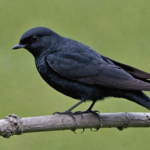The Raven: A Look into the Mysterious Bird of Darkness and Noise
The raven, known as the “Grand corbeau” in its scientific name Corvus corax, has long been associated with misfortune, sadness, and superstition. However, this intelligent bird is often misunderstood and overshadowed by its negative image. The largest passerine bird in Europe, the raven is a fascinating creature with many admirable qualities. Let’s delve into the world of this captivating corvid with its lustrous black plumage.
The Raven: A Bird of Enigma
Belonging to the order Passeriformes and the family Corvidae, the raven is an impressive bird with a powerful body. It measures around 69 cm in length, with a wingspan ranging from 116 cm to 118 cm and a weight between 690 g and 1600 g. Its sleek black plumage showcases subtle blue iridescent reflections, while the feathers on its belly cascade down to its legs. The raven sports a large, strong, and slightly curved beak, reminiscent of a dagger. Its eyes are dark with a thin gray circle around the iris, and it has substantial legs.
With long, pointed wings and a wedge-shaped tail, the raven’s aerial acrobatics are distinguishable. Its wing beats are short and rigid, interrupted by gliding flights. While notorious for its hoarse and deep croaking sounds, the raven is also capable of producing a wide range of varied tones and even imitating other bird species’ calls.
Differentiating the Raven from Other Birds
Often confused with other species, the grand corbeau, freux corbeau, and corneille noire all share the same habitats. However, their interactions provide a better understanding of their distinctions. The corneille noire, for instance, is entirely black with a duller plumage slightly tinted with brown. It emits a characteristic “rhaaa” sound and prefers hopping to walking on the ground. In flight, it does not glide like the raven.
The freux corbeau, similar in size to the corneille noire, can be recognized by its gray beak and more prominent forehead. Its plumage appears more disheveled, and its call is shriller and shorter. Unlike the other two species, the freux corbeau is a migratory bird capable of soaring in flight.
The grand corbeau, significantly larger than the other two species, is easily distinguishable when seen alongside them.
A Highly Intelligent Animal
The raven is a gregarious bird, often seen engaging in group activities during the day and resting in communal roosts at night. While the young ravens exhibit this behavior year-round, adults become more territorial during the breeding season. Known for its remarkable intelligence, the raven can anticipate and make choices to gain rewards or derive future benefits.
Habitat and Distribution
The raven is found throughout the Northern Hemisphere, inhabiting various environments in Europe, Asia, the British Isles, Iceland, Greenland, North America, Central America, the Canary Islands, and the Maghreb region. Although it can adapt to diverse ecosystems, the raven tends to avoid human presence and prefers nesting in remote, wild areas such as cliffs, tall trees, or quarries. However, it can also be found in urban areas, perched on buildings, under bridges, on electrical pylons, or in abandoned structures.
A Varied Diet
The raven is primarily a scavenger, feasting on carcasses of animals. However, it is also an omnivore, enjoying insects, worms, snails, rodents, frogs, small mammals or birds, as well as seeds and fruits, including cherries. It is not uncommon to find ravens scouring agricultural fields, landfills, and roadways in search of food. In urban areas, they can be seen foraging among human food waste. Ravens feed on the ground in open areas and have the foresight to store food for leaner times.
Reproduction of the Raven
The raven is a sedentary and monogamous bird that reaches sexual maturity around the age of three. The breeding period begins in late winter when the couple becomes more territorial, engaging in aerial displays and nest building. The male puffs up the feathers on his throat, spreads his wings, and extends his neck. Once ready to mate, the female assumes a squatting position, inviting her partner.
The raven nests from February to mid-April, or even early May, at great heights such as cliffs, tall trees, or pylons. The substantial nest is made of branches and twigs, lined with grass, moss, wool, and lichen. The couple often reinforces the nest with mud.
The female lays between 3 and 7 light-colored eggs speckled with dark spots per clutch, which she incubates for 18 to 21 days while the male provides food. The hatchlings are fed by both parents regurgitating food into their throats until they fledge after 5 to 7 weeks. Generally, the couple raises only one brood per year.
The Raven: Friend or Foe to the Garden?
While the raven may consume fruits and buds of trees, making it less favorable to orchard cultivators, it also serves as a natural predator to various pests that can harm gardens. Additionally, caution is advised for those with chicken coops, as ravens have been known to prey on chickens during harsh winters when food is scarce. They may also target egg-laying areas in search of a quick meal. However, the raven’s role as a scavenger and predator can be beneficial in keeping garden nuisances at bay.



